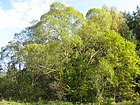Note: This is a project under development. The articles on this wiki are just being initiated and broadly incomplete. You can Help creating new pages.
Salix fragilis
Salix fragilis is a deciduous tree that can grow up to 15.00 metres tall. It is harvested from the wild for local use as a food, medicine and source of materials.
Contents
[hide]- 1 Uses
- 2 Parts Used
- 3 Chemical Composition
- 4 Common names
- 5 Properties
- 6 Habit
- 7 Identification
- 8 List of Ayurvedic medicine in which the herb is used
- 9 Where to get the saplings
- 10 Mode of Propagation
- 11 How to plant/cultivate
- 12 Commonly seen growing in areas
- 13 Photo Gallery
- 14 References
- 15 External Links
Uses
Rheumatism, Arthritis, Gout, Immune diseases, Diarrhoea, Dysentery, Feverish illnesses, Neuralgia, Headache.[1]
Parts Used
Chemical Composition
It contains much of the carbohydrates, phenolic compounds, and tannins were leached from the leaves within the first week. Nitrogen and chlorophyll a concentrations increased as a percentage of ash‐free dry mass throughout the study period, whereas protein concentration remained relatively constant.[2]
Common names
| Language | Common name |
|---|---|
| Kannada | |
| Hindi | |
| Malayalam | |
| Tamil | |
| Telugu | |
| Marathi | |
| Gujarathi | |
| Punjabi | |
| Kashmiri | |
| Sanskrit | |
| English |
Properties
Reference: Dravya - Substance, Rasa - Taste, Guna - Qualities, Veerya - Potency, Vipaka - Post-digesion effect, Karma - Pharmacological activity, Prabhava - Therepeutics.
Dravya
Rasa
Guna
Veerya
Vipaka
Karma
Prabhava
Habit
Identification
Leaf
| Kind | Shape | Feature |
|---|---|---|
Flower
| Type | Size | Color and composition | Stamen | More information |
|---|---|---|---|---|
| {{{5}}} |
Fruit
| Type | Size | Mass | Appearance | Seeds | More information |
|---|---|---|---|---|---|
Other features
List of Ayurvedic medicine in which the herb is used
Where to get the saplings
Mode of Propagation
Seeds, Cuttings of mature wood, Cuttings of half-ripe wood.
How to plant/cultivate
Succeeds in most soils, including wet, ill-drained or intermittently flooded soils, but prefers a deep damp, heavy soil in a sunny position. Rarely thrives on chalk. Succeeds in an exposed position.[4]
Commonly seen growing in areas
Photo Gallery
References
- Jump up ↑ Indian Medicinal Plants by C.P.Khare
- Jump up ↑ Chemical constituents
- Jump up ↑ [Morphology]
- Jump up ↑ Cultivation
External Links
- Ayurvedic Herbs known to be helpful to treat Rheumatism
- Ayurvedic Herbs known to be helpful to treat Arthritis
- Ayurvedic Herbs known to be helpful to treat Gout
- Ayurvedic Herbs known to be helpful to treat Immune diseases
- Ayurvedic Herbs known to be helpful to treat Diarrhoea
- Ayurvedic Herbs known to be helpful to treat Dysentery
- Ayurvedic Herbs known to be helpful to treat Feverish illnesses
- Ayurvedic Herbs known to be helpful to treat Neuralgia
- Ayurvedic Herbs known to be helpful to treat Headache
- Herbs with Inner bark used in medicine
- Herbs with Young shoot used in medicine
- Habit - Deciduous tree
- Index of Plants which can be propagated by Seeds
- Index of Plants which can be propagated by Cuttings of mature wood
- Index of Plants which can be propagated by Cuttings of half-ripe wood
- Herbs that are commonly seen in the region of Streamsides
- Herbs that are commonly seen in the region of Marshes
- Herbs






